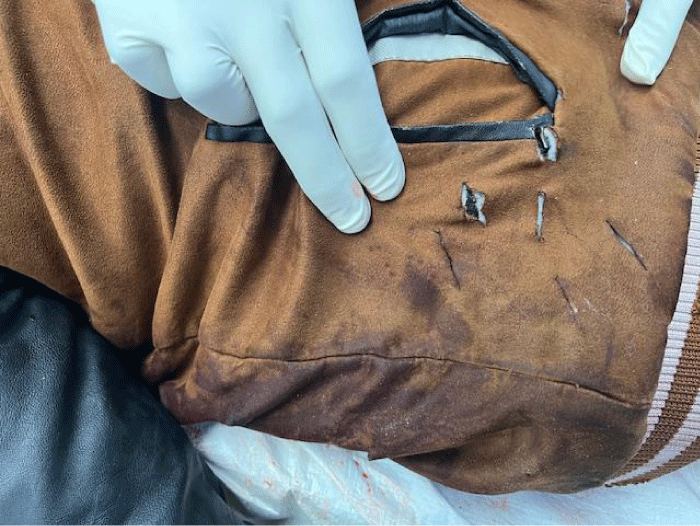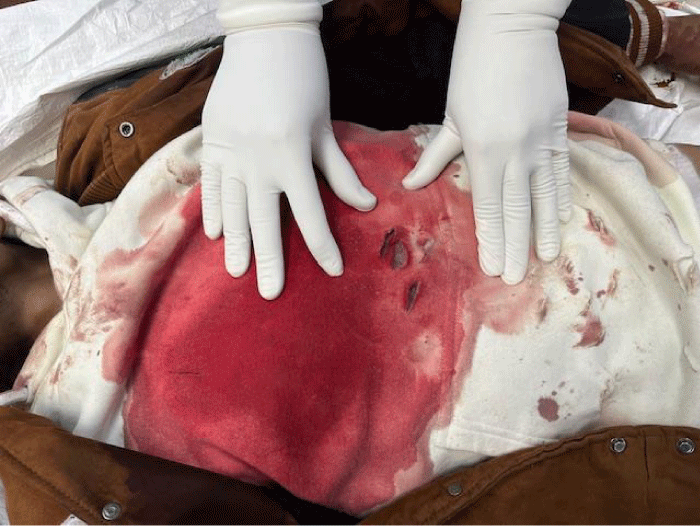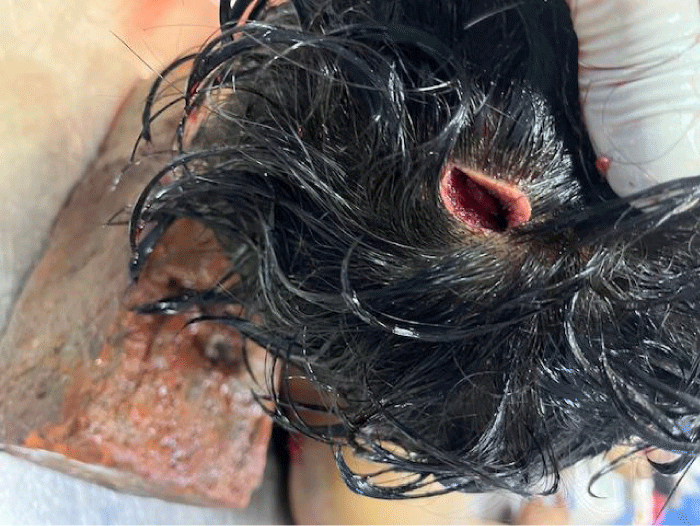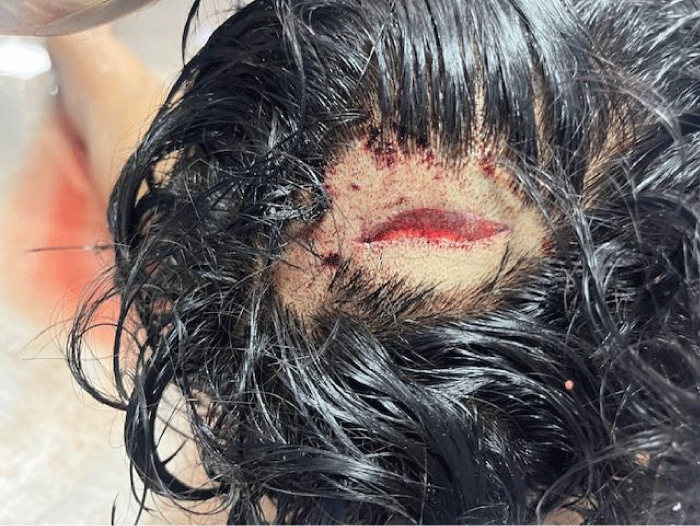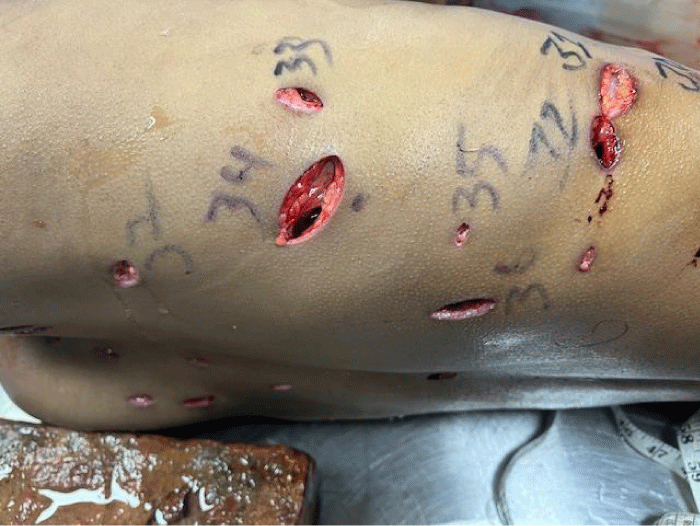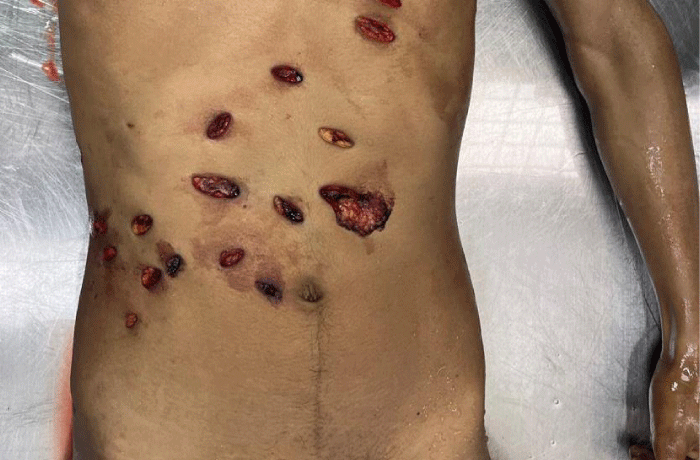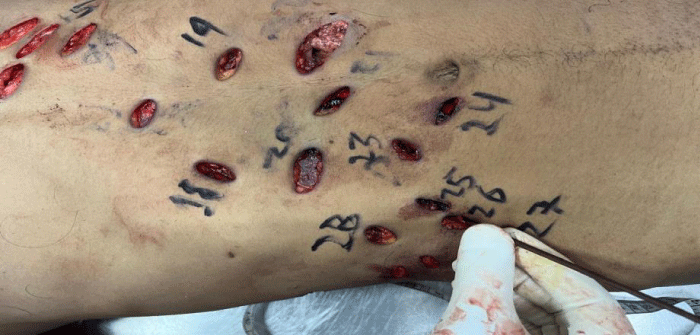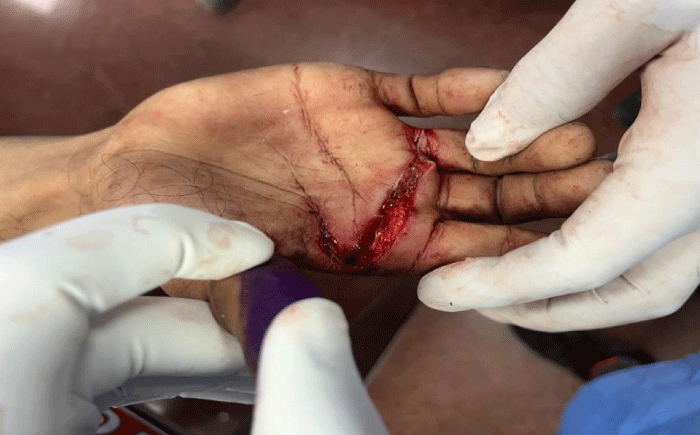More Information
Submitted: March 29, 2025 | Approved: April 03, 2025 | Published: April 04, 2025
How to cite this article: Hussain A. Forensic Insights into Multiple Stab Wounds: Autopsy Findings from a Case of Sixty Stab Wounds. J Forensic Sci Res. 2025; 9(1): 021-024. Available from:
https://dx.doi.org/10.29328/journal.jfsr.1001075
DOI: 10.29328/journal.jfsr.1001075
Copyright License: © 2025 Hussain A. This is an open access article distributed under the Creative Commons Attribution License, which permits unrestricted use, distribution, and reproduction in any medium, provided the original work is properly cited.
Keywords: Multiple stab wounds; Homicidal; Autopsy findings
Forensic Insights into Multiple Stab Wounds: Autopsy Findings from a Case of Sixty Stab Wounds
Asif Hussain*
University College of Medical Sciences, GTB Hospital Dilshad Garden New Delhi-110095, India
*Address for Correspondence: Dr. Asif Hussain, MBBS, MD, Senior Resident, University College of Medical Sciences, GTB Hospital Dilshad Garden New Delhi-110095, India, Email: [email protected]
Multiple stab wounds are a critical forensic indicator, frequently linked to violent assaults, homicides, or self-inflicted injuries. These penetrating injuries result from sharp-edged weapons such as knives, daggers, or other pointed instruments. The depth, size, and severity of the wounds depend on factors including the type of weapon used, the force applied, and the anatomical location of impact. Forensic examination of stab wounds is essential in determining the manner of death—homicidal, suicidal, or accidental. Detailed analysis of wound characteristics, such as depth, trajectory, and associated injuries, aids in crime scene reconstruction. Additionally, identifying defensive wounds can indicate victim resistance, further supporting forensic interpretations. A meticulous forensic autopsy, including weapon analysis and internal organ assessment, is crucial in establishing the cause of death. These findings play a vital role in medico-legal investigations, providing key forensic evidence that supports legal proceedings and ensures justice.
Multiple stab wounds refer to a series of penetrating injuries inflicted by a sharp instrument, such as a knife, resulting in varying degrees of damage to the body. The characteristics of these wounds, including their depth, direction, and location, are influenced by multiple factors such as the force applied, the angle of penetration, and the anatomical site targeted [1,2]. In forensic investigations, the presence of multiple stab wounds is often indicative of an intentional, violent act, and careful analysis is required to establish the cause of death, the sequence of injuries, and whether any defensive wounds were present [3,4]. The sequence in which the wounds were inflicted is also a critical aspect to assess, as it can provide important clues regarding the dynamics of the attack, such as whether the victim was standing, seated, or lying down during the assault.
Forensic autopsies are a cornerstone of such investigations. These post-mortem examinations allow forensic pathologists to accurately assess the injuries and offer a detailed account of the victim's injuries, including the potential role each wound played in the cause of death. Autopsies also help to identify any additional contributing factors, such as underlying health conditions or toxic substances that could have affected the victim’s vulnerability or the fatal outcome. The findings from these autopsies are crucial for supporting criminal investigations, offering objective evidence that can aid in identifying the perpetrator and providing the legal system with clear, scientifically-backed information to help ensure justice [5].
This case report aims to present a forensic autopsy of a victim who sustained multiple stab wounds (60), demonstrating the indispensable role of forensic expertise during autopsy. By providing a detailed examination of the victim's injuries, this report underscores the critical importance of forensic autopsies in understanding the cause of death; interpret the dynamics of the attack and injury pattern.
On December 27, 2023, at approximately 8:30 PM, a 28-year-old man of average build and lean physique was assaulted with a sharp weapon by a group of three individuals during a dispute over a girl. The attack occurred while the victim was passing through the area, with the assailants ambushing him from behind and fatally stabbing him.
Notably, a day prior to the incident, the deceased had allegedly attempted to murder one of the attackers but failed. Following the assault, he was rushed to the main casualty unit of Delhi Hospital in an unconscious and unresponsive state. Despite medical efforts, he was declared brought dead at 11:55 PM on the same day.
There was no history of psychiatric illness or prior suicide attempts. The deceased was dressed in a brown-black full-sleeve jacket, a white full-sleeve sweater, a white hoodie, black pants, and a pair of white athletic shoes (Figure 1). All clothing items had multiple cut marks and were soiled with dirt and blood. The cuts on the garments corresponded to the underlying injuries (Figure 2). The clothing was carefully removed, air-dried, labelled, and preserved.
Figure 1: Deceased was dressed in a brown-black full-sleeve jacket with multiple cut marks.
Figure 2: The clothing items of the deceased exhibited multiple cut marks and were stained with dirt and blood.
Upon external examination, the eyes appeared pale when opened, and the mouth was closed. The frenulums of both the upper and lower lips were intact. Dried blood stains were noted on the face, chest, abdomen, and back. All other natural openings appeared normal (NAD).
Post-mortem findings
- Post-mortem staining was faintly present over the dependent areas of the back, except for pressure points, and was fixed in nature.
- Rigor mortis was well-developed throughout the body.
- No signs of decomposition were observed at the time of examination.
Details of injuries
The post-mortem examination revealed extensive sharp force injuries across multiple regions of the body, inflicted by sharp force object. Two scalp-deep incisions both sharp and clean-cut were observed on the back of the head. Incision 1 (2.4 cm × 0.2 cm) was oblique, with its lower medial end touching the midline, 2.5 cm above the occipital protuberance (Figure 3). Incision 2 (3.2 cm × 0.2 cm) was horizontally oriented on the back of the head (Figure 4). The dura mater was intact. Upon removal, the brain weighed 1410 g and appeared pale.
Figure 3: A figure illustrating Incision 2, a horizontally oriented scalp incision measuring 3.2 cm × 0.2 cm.
Figure 4: Illustrates fifteen stab wounds present on the rib cage.
Upon opening the chest, 800 mL of blood with clots was found in the pleural cavity. Fifteen stab wounds were present on the rib cage (Figure 5). A 5.0 cm deep wound on the right chest fractured the 3rd rib and pierced the upper lobe of right lung (Figure 6). Four stab wounds (3.0 cm - 3.5 cm) on the left chest fractured ribs and injured both lung lobes. Wound tracks measured 14.0 cm - 15.0 cm, with extensive hemorrhage indicating fatal trauma. The post-mortem revealed severe lung trauma. The right lung (200 g) had eight stab wounds, including a 2.5 cm deep wound fracturing the 5th rib and a 2.0 cm wound fracturing the 7th rib. The left lung (190 g) had ten stab wounds, with a 2.5 cm wound fracturing the 5th rib and a 3.0 cm wound fracturing the 8th rib. Blood effusion was present throughout.
Figure 5: Illustrates fifteen stab wounds present on the rib cage.
Figure 6: Shows a 5.0 cm deep wound on the right chest, fracturing the 3rd rib and piercing the upper lobe of the right lung.
Upon abdominal opening, 1000 mL of blood with clots was observed. The stomach contained 200 mL of semi-digested food. Fourteen stab wounds were present, including a 2.2 cm wound damaging the mesentery and intestines (8.5 cm track) and a 3.5 cm wound affecting the pancreas, stomach, and intestines (9.5 cm track) (Figure 7). A 3.5 cm wound fractured the 8th rib and damaged the liver. The liver (960 g) had multiple stab wounds, including a 3.0 cm wound fracturing the 7th rib (4.0 cm track) and a 2.0 cm wound fracturing the 6th rib (2.5 cm track) (Figure 8). Blood effusion was present throughout.
Figure 7: Shows fourteen stab wounds, including a 2.2 cm wound (8.5 cm track) damaging the mesentery and intestines, and a 3.5 cm wound (9.5 cm track) affecting the pancreas, stomach, and intestines.
Figure 8: Depicts the liver with multiple stab wounds.
The heart was intact, and all coronary arteries were patent. The kidneys and urinary bladder appeared pale but structurally normal. Defensive wounds observed on the palms of both hands (Figure 9). Despite the absence of fractures in the vertebral column and pelvis, the overall severity of the wounds inflicted extensive trauma. The cumulative impact of the sustained injuries was sufficient to cause death, both individually and collectively, in the ordinary course of nature.The extensive internal bleeding, multiple organ damage, and penetrating trauma to vital structures indicate a highly fatal outcome. All injuries were ante-mortem, fresh before death, and homicidal in nature.
Figure 9: Shows defensive wounds on the palms of hands.
This post-mortem examination report details an extremely violent assault involving numerous stab wounds, primarily affecting the chest and abdomen. The findings suggest a sustained attack using a sharp force weapon, likely a knife or similar object, resulting in fatal haemorrhage and organ damage.
Handlos, et al.'s [6] study examined injury patterns in homicides caused by sharp force trauma over a 13-year period, categorizing wounds based on location, severity, number, and the presence of defensive injuries. The study found that 79% of victims sustained multiple sharp force injuries, with a median of five stab wounds per victim, though some cases involved more than ten. While penetrating injuries to the abdominal cavity were less frequent, they were often highly lethal, particularly when affecting the liver, intestines, and major blood vessels. Notably, the study's findings align closely with the present case, reinforcing that the chest is the most commonly targeted region in homicidal sharp force injuries.
A stab wound to the chest can damage critical structures such as the heart, lungs, and major blood vessels, often leading to life-threatening complications like hemothorax, pneumothorax, and cardiac tamponade. A retrospective review of 100 consecutive cases of chest stab wounds reported mortality rates exceeding 60% in cases involving cardiac injury [7]. However, in the present case, the heart and its structures remain unaffected, reducing the risk of severe cardiac complications.
In cases of multiple stab wounds, the liver is one of the most frequently affected organs. A study analyzing fatal stab wound cases found that penetrating injuries to the chest or abdomen often resulted in damage to the liver or stomach. Notably, the study identified penetrating stab wounds involving the stomach or liver as the second most common injury pattern, which aligns with the present case [8].
A case study reported a stab wound to the right back that penetrated the right lower lung and extended into the right liver lobe, while another stab wound to the left back injured the lower left lung [9]. These findings highlight the frequent involvement of the liver and lungs in penetrating injuries, reflecting similarities to the present case. In cases of multiple stab wounds, forensic examination plays a crucial role in determining the cause, manner, and mechanism of death. The pattern, depth, and trajectory of the wounds provide valuable insights into the nature of the attack, the possible weapon used, and the intent of the assailant. The presence of multiple penetrating injuries suggests a high degree of force and intent, further supporting a homicidal manner of death. A meticulous autopsy, along with histo-pathological and toxicological analysis, is essential for reconstructing the sequence of events leading to death. These findings contribute to medico-legal investigations and help establish critical forensic evidence in legal proceedings.
I sincerely acknowledge the deceased and their family for their invaluable contribution to this case report, and I extend my deepest respect and gratitude.
- Gilchrist MD, Keenan S, Curtis M, Cassidy M, Byrne G, Destrade M. Mechanics of stabbing: Biaxial measurement of knife stab penetration of skin simulant [Internet]. 2008 Nov 24. Available from: https://doi.org/10.48550/arXiv.0811.3955
- Stab wounds. Forensic Medicine for Medical Students [Internet]. Available from: https://www.forensicmed.co.uk/wounds/sharp-force-trauma/stab-wounds/
- Miletich JJ, Lindstrom TL. An introduction to the work of a medical examiner: from death scene to autopsy suite. Westport (CT): Greenwood Publishing Group; 2010. p. 84. Available from: https://www.bloomsbury.com/in/introduction-to-the-work-of-a-medical-examiner-9780275995096/
- Perwira S, Ramadhani P, Tambunan E, Yudianto A. Forensic autopsy of multiple stab wound. Sriwijaya J Forensic Med [Internet]. 2024;2(1):47-52. Available from: https://doi.org/10.59345/sjfm.v2i1.103
- Galante V. The vital role of forensic autopsy in legal proceedings. J Forensic Med [Internet]. 2024;9:356. Available from: https://www.hilarispublisher.com/open-access/the-vital-role-of-forensic-autopsy-in-legal-proceedings-105925.html
- Handlos J, Hejna P, Rousová V, Dobiáš M, Straka L, Janík M, et al. Review of patterns in homicides by sharp force: one institution’s experience. Forensic Sci Med Pathol [Internet]. 2023;19(1):525–533. Available from: https://link.springer.com/article/10.1007/s12024-023-00576-8
- Bailey H, Barlow G, Mains J, James A. Stab wounds to the chest: a retrospective review of 100 consecutive cases. J Trauma. 2024 Oct 22;45(3):456-62.
- Chowdhury RJ, Islam MS, Ahmed M, Khatun M, Alam MM. Injury pattern in fatal cases of stab wound. Med Today [Internet]. 2019;31(2):76-79. Available from: https://doi.org/10.3329/medtoday.v31i2.41955
- Sriwijaya Journal of Forensic Medicine. Vol. 2, Issue 2. Phlox Institute; 2024 Nov 27 [Internet]. Available from: https://phlox.or.id/index.php/SJFM
